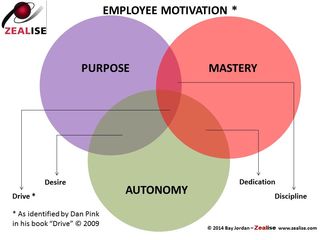In my blog last week (Revealed: The Link between Purpose and Powerful Employee Engagement) I illustrated how the three principle elements of purpose drove both personal and organisational behaviour. In doing so, I argued that this link provides a powerful lever for building significant employee engagement that will inevitably improve your organisational performance and results. Well, today, I want to build on that and show you how you can build on that to create a model that will embed this into your organisation.
Let’s start by taking a fresh look at what Daniel Pink says are the principle elements of motivation: autonomy, mastery and purpose. Remember he says that these are all intrinsic – innate to the individual. The combination of the three is what he calls “drive” but what you and I, in an organisational context, would call employee engagement.
Yet, describing these three elements as intrinsic is a subtle way of making the point that you cannot motivate your people! It is fundamentally something they have to do for themselves: something that has to come from within their being. The best you can do is to create an environment and culture that encourages, enables and – if you want it to endure – embeds this. But what are we actually talking about here?
Motivation is powered by motive and both have the same Latin root meaning to move. Thus, motivation is broadly a synonym for intention or purpose, distinguished by its causal relationship to action, best exemplified by the courts looking at motive as a key factor behind a crime. Yet when you look at it in this light you can begin to see why purpose should play the powerful part in employee engagement that I ascribe to it. After all, purpose ultimately shapes all behaviour.
Nevertheless saying that motivation is the same as purpose and that purpose is a primary driver of motivation, at best, seems a little clumsy. So let’s look at it another way. After all Pink’s terms are only his words, and last week, building on my own interpretation of the elements of purpose, I initially respectively labelled them as motive, skill and usefulness. Those still leave us with some potential for confusion so let me put forward some alternatives.
Firstly, let’s replace purpose with “attitude”. After all, attitude is a powerful shaper of behaviour and is perhaps just as fundamental as purpose. Arguably the two could be used interchangeably, with any argument being about semantics.
And while there is nothing inherently wrong with the word “mastery” it could be comfortably replaced by “ability” which – in the context of employment – allows more leeway for growth in a role than is implied by “mastery.”
Now let’s consider “autonomy.” Another perfectly good word for my “usefulness”, chosen to invoke that very human desire to be independent and appreciated, and to counter any possible interpretation of autonomous as being too independent and individualistic and therefore being unwilling to seek help when it is appropriate to do so. In any event, both require a context so why not compromise with the word “application” which combines the requirements of attitude and ability.
Using these three terms you now have a figure that looks like this.
This is extremely powerful. Why? Because:-
- The terms are generally more readily understandable, less subjective and therefore require less thought than may be the case with the others.
- The link between individual and organisation purpose and their fit with employee engagement is clear and creates a platform for embedding this engagement.
- The terms lend themselves more readily to assessment and measurement.
In fact this is what underpins the new Zealise “Triple A Employee ® Model”: a system to help you assess performance on an ongoing basis whilst simultaneously reinforcing the key elements of all your endeavours to engender and sustain employee engagement. It provides the framework for you to align the three drivers of individual and organisational purpose, creating more engaged employees and so transforming your organisational performance and enabling you to sustain that transformation.
Bay is the founder and director of Zealise, a company created to help larger small to large business organisations to properly value their people and thereby inspire them to optimise their self-worth and so engage them that they transform organisational performance and bottom-line results. Bay is also the author of several books, including “Lean Organisations Need FAT People” and “The 7 Deadly Toxins of Employee Engagement.”

